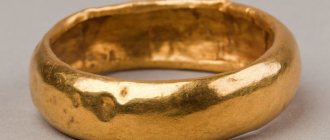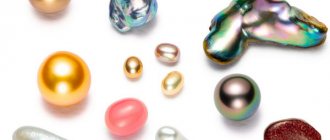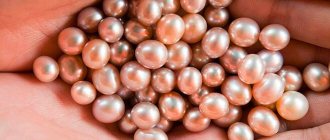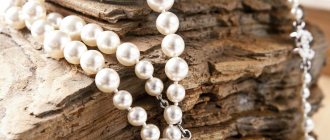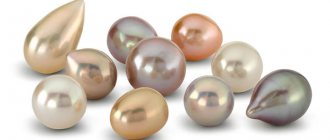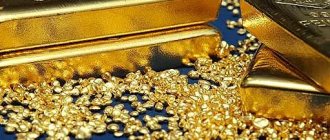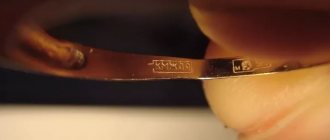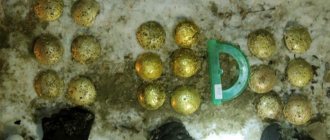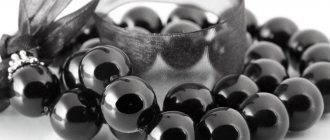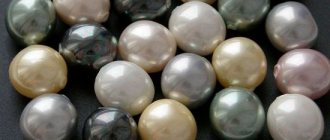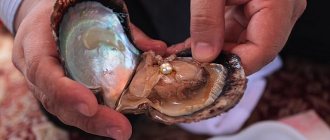At the moment, about one hundred and twenty colors of pearls are known to man. Among them there are such beautiful shades as pink, gold, gray, black, white, blue, red, silver, cream, dark brown, purple, blue, green, yellow and many others.
A waste product of a mollusk that has a spherical or asymmetrical shape. Is a gem.
It is interesting that people associate pearls with a white stone. But in its pure form, this shade is not often found in nature. The most common tone is silver, the most unique is blue.
History and origin
Pearl is a stone of organic origin. It is not a mineral, from the point of view of scientists, but according to a tradition that is about four thousand years old, it is classified as a precious stone. The cost of pearls was very high until the 20s of the 20th century, and subsequently decreased significantly due to the collapse of the market as a result of the work of Japanese pearl farms.
Pearl
Pearls are formed in the organisms of various marine and freshwater mollusks and are a product of a natural rejection reaction to a foreign object that has entered the shell of a mollusk - a grain of sand, a shell fragment, etc. If this object comes into contact with the mollusk's mantle (the outer soft shell hiding under the shell), the mollusk covers it with a layer of the same material that makes up its shell. As a result, a pearl is formed.
In the same shell of an invertebrate animal, up to several dozen pearls of different shapes can form, but the more there are, the smaller they are, accordingly. Only those pearls that have a mother-of-pearl shell are valued.
Zoologists believe that any species of mollusk is capable of producing pearls, but they find pearls only inside some bivalves and gastropods, as well as in the shells of a single species of cephalopod - the famous nautilus.
Scientists believe that the first pearls were caught by fishermen by accident - discovered while catching edible bivalves. This happened about four thousand years ago, in the waters of the shallow Gulf of Mannar (a pseudo-sea between Hindustan and the island of Ceylon). Due to the fact that pearls are the only precious stone that does not require additional processing, they began to be used as jewelry, as well as as a monetary equivalent.
Pearl
Pearls were very highly valued throughout the East - from Eastern China, the extreme point of mainland Asia, to North Africa - Egypt, Numidia and ancient Carthage. The importance of pearls for the ancients was so great that the famous Queen Cleopatra considered earrings with two large pearls to be the most valuable of her jewelry. Statues of gods and heroes were decorated with pearls, pearls were awarded for military exploits, and pearls were given for love. It was highly valued in all countries that had access to the sea, although prices varied depending on the color, size and shape of the pearl.
The origin of the Russian word “pearl” is associated with the Chinese name for this stone - “zhen zhu”, which came to our country through the ancient Turkic and Volga-Bulgar languages. In most European languages, the name has the Latin root perl. It comes from a no longer used word that denoted a specific type of shellfish that was harvested by the ancient Latins. In Russian, nacre is a synonym for pearls; in a more precise meaning, it is the “front” coating of a pearl.
Pearl blister
Pearl blister in shells
Pendant with pearls blister from Nasonpearl
In some cases, the formation and growth of a pearl occurs on one of the inner sides of the shell. This leads to the fact that a pearlescent layer does not form at the site of its growth. Such pearls are less valued and undergo additional processing for use in jewelry.
Advertising - Continued below
Blister pearls have another, less common name - bubble pearls, which is due to their unusual appearance.
Physicochemical characteristics
From a chemical point of view, it is a composite of an inorganic substance - calcium carbonate, and an organic substance - conchiolin, a horny substance produced by the mollusk. When examined under a microscope, a layered structure is revealed, with layers of different natures not touching each other.
The chemical formula of the substance is very complex, since conchiolin is a natural polymer of a protein structure. The hardness of pearls is low, 3–4 units on the Mohs scale. It is easy to drill, but cannot be sanded, since in this case the mother-of-pearl layer is erased. It is opaque, but individual pearls may be translucent (depending on the type of pearl).
| Property | Description |
| Formula | CaCO3 |
| Color | White, yellowish, silver, golden, cream, blue, green, black, gray, pink |
| Shine | Pearl |
| Transparency | From translucent to opaque. |
| Hardness | 3-4 |
| Cleavage | Absent |
| Kink | Shellish |
| Density | 2.6-2.78 g/cm³ |
Pearl soufflé
Airy pearl soufflé
Stud earrings with soufflé pearls and a ruby geode inside from Little h
The delicious name for pearls was invented by Jack Lynch, a recognized expert in this field. Such a comparison very accurately reflects the essence of the technology for its production. Translated from French, soufflé means “to inflate”, “to pump up”. In this case, the object of “inflation” is the pearl sac of the oyster after the formed pearl has been removed from it.
Dry earthy material is placed inside the soufflé pearl bag, which, gradually swelling with moisture, stretches it. The oyster continues to lay nacre around the new core, and thus grows pearls of impressive size, the quality and price of which depends on the thickness of the nacre layer.
Mining locations
Pearls are obtained by opening the shells of marine and freshwater mollusks, mainly bivalves (the closest example is the mussel). The main areas for harvesting sea “wild” pearls are warm, shallow seas:
- Gulf of Mannar;
- Persian Gulf;
- Red sea.
Cultured pearls are mined off the coast of Japan, as well as in some lakes in the Land of the Rising Sun. Cultivated pearls are no different from wild ones, except that on pearl farms the core of the future pearl is artificially placed in mollusk shells. After this, the invertebrate grows (and grows the jewel inside) under the supervision of specialists for several years.
Cultured mother-of-pearl is not artificial or counterfeit, but its price is significantly lower due to controlled production. However, it depends on the color of the pearl, its size, shine and other parameters. Some cultural specimens are valued as precious stones more than those generated by nature.
Cultured pearls
There are also freshwater pearls, which are mined in large and clean rivers in Asia, Europe and North America. Its cost is lower, since (on average) it is smaller than sea and less often has a regular spherical shape. The main suppliers of freshwater pearls are Russia, Germany and China.
Pearl melo melo
The pearls are chalk. Photo: pearlsinternational.com
Necklace with pearls from Mikimoto
This type of pearl is very similar to conch pearls - both of them do not have a mother-of-pearl layer, and therefore many do not classify them as pearls at all. However, one of the largest gemological institutes, GIA, when issuing a certificate for a precious stone, officially classifies melo (or melo melo, as it is also called) as a pearl, or adds the clarification that it is “not mother-of-pearl.”
Advertising - Continued below
The source of melo pearls is the huge sea snail melo melo. It can be found off the coast of Thailand, Vietnam, as well as Myanmar and Cambodia. The palette consists of shades of orange, yellow, red and brown, among which the first are valued above the rest.
Melo pearls, although very rare, can be quite large in size. The largest pearl in the world is considered to be weighing almost 400 carats (about 80 grams). It belonged to the last emperor of Vietnam, Bao Dai, and is called Sunrise Pearl for its resemblance to the bright sun at sunrise.
The most expensive melo melo pearl was sold for $488,000 at a Christie's auction in 1999. The dimensions of the bright orange gemstone were 23x19 millimeters.
Chalk is not amenable to cultivation and is very sensitive to sunlight - with prolonged exposure, the color of pearls fades, so jewelry with it is recommended to be worn only in the evening.
Advertising - Continued below
Colors and varieties
Pearl colors range from milky white to various light shades of green, blue and pink. Available in silver, grey, deep green and black. Color plays an important role in the evaluation of pearls: black, deep blue and completely white (without the slightest shade of cream or gray) specimens are most valued, since they are the rarest in nature.
Mother-of-pearl gives a specific play of light on the surface - from soft yellow to blue and pink. This occurs because light interferes with the irregular, wavy surface of the pearl, which only appears smooth.
Jewelers classify pearls by size, color, luster, thickness of the nacre layer, surface cleanliness (absence of defects) and shape. The most valuable specimens are those in the form of a perfect sphere with a thick layer of mother-of-pearl, without visible defects and with a bright shine. Pear-shaped and oval pearls, as well as irregularly shaped specimens, are less valued. But some connoisseurs have so-called “monsters” or “paragons”, which outwardly resemble figures of people or animals.
The shape and color of the pearl depend on the type of mollusk, the salinity and purity of the water in which it lived, as well as its temperature.
Types of pearls:
- river - natural, small (up to 7 mm in diameter), white, cream, yellowish or grayish in color, shape varies from spherical to elliptical;
Freshwater pearl necklace - "Tahiti" - cultivated, medium size (up to 12 mm in diameter), shades from silver to black;
Pearls "Tahiti" - “Akoya” - cultivated, all colors except blue, diameter up to 14 mm;
"Akoya" - “king” - natural, large (up to 22 mm), of all colors, with a thick layer of mother-of-pearl, found only in the southern seas;
"King" - "Mabe" - natural, very large, perfectly round in shape, color range - from silver through lead gray to black;
"Mabe" - "Kasumi" - cultured Japanese pearls of exotic colors, from gold to purple;
"Kasumi" - “Baroque” (as well as “paragons” and “monsters”) - small, up to 5 mm, different shades of white, gray and cream, irregular in shape.
Baroque pearls
Products made from artificially grown or synthesized mother-of-pearl stones stand apart. Imitation pearls are always perfectly spherical in shape.
Conch pearls
Conch pearls
Necklace with 32 conch pearls from Boghossian Jewel
Giant conch mollusks live in the Caribbean Sea. When the shell is opened, it dies, so conch pearls are not cultured. Caribbean pearls are difficult to confuse with others; in appearance they look more like small stones. Conch mollusks are not able to secrete mother-of-pearl, so their pearls do not have an iridescent sheen, but this does not make them any less beautiful.
Advertising - Continued below
The texture of this extraordinary pearl resembles wet silk, filled with frozen flashes of fire. The shape is usually regular - oval or spherical, but the color scheme is unique. There are pearls of olive, purple, and amber shades, but pink, purple and lilac specimens are considered the most valuable and rare.
Medicinal properties
The healing properties of pearls are associated, firstly, with its ability to diagnose the body, and secondly, with the ability to restore problem areas in organs associated with the removal of excess fluid from the body and the digestive tract. Pearls are suitable for those who suffer from stomach diseases associated with changes in acidity, and also have problems with the kidneys and liver, and to a lesser extent, with the intestines.
The diagnostic properties of pearls are due to the fact that they change their color if the acidity of the upper layers of the skin changes in the owner. This in itself indicates unfavorable processes that have begun in the body. Some lithotherapists believe that if a pearl fades, loses its shine and becomes cloudy, this means the emergence of a tumor process in the body (mainly in the abdominal organs). Thus, mother of pearl signals when it is time to see a doctor to check the whole body. To some extent, it is able to “slow down” the development of the disease.
People suffering from conjunctivitis and other eye diseases associated with constant discharge from the eyes can wear pearls. It will help reduce the amount of discharge.
Letter classification
- Quality D is the lowest for pearls. This rating is given to weakly shiny stones with numerous visible defects occupying more than 2/3 of the surface.
- Quality C - good gloss and the number of defects up to 2/3 of the surface.
- Quality B - small but visible defects occupy up to 1/3 of the surface, which has good gloss indicators.
- Quality A is the highest quality pearl. A surface without visible defects, allowing minor damage (no more than 10%) and having good reflective properties.
As a rule, jewelers do not use quality D and C pearls in jewelry.
Magic properties
The magical properties of pearls are similar to healing ones. The main one is the ability to darken, fade, lose color if the owner is negatively affected (damage, the evil eye, other types of magical attacks). But at the same time, pearls are a very finicky stone. He wants to protect and protect only people who are pure in soul, and even among them he does not like those who are wayward, prone to fits of anger or pride.
Kasumi pearls with smoky surface
Pearls cannot stand people who are unable to keep their word, who are treacherous and deceitful. Including those who lie to themselves.
In different cultures, pearls are symbols of purity, purity, sincerity of thoughts and the predominance of the divine (sublime) over the earthly (carnal). In Asian countries, jewelry with pearls is used as amulets and at the same time detectors of bad thoughts and intentions directed at the owner. The scope of application is wide: business transactions, love affairs, health and childbirth, maintaining peace and order in the family and so on.
Contraindications
Please note: the properties of pearls are such that this stone is not suitable for anyone. It should not be worn by weak-willed people who are prone to weakening self-concentration and depression, especially men who have problems with self-esteem and an unstable psyche. The magic of pearls is suitable mainly for women, for them it enhances classic feminine qualities - softness, maternal wisdom, gives femininity and charm. If pearl products are worn by men, then the characteristic features of a woman’s character are transmitted to them.
This is beneficial, for example, for business people, businessmen and politicians who could use a little flexibility and flexibility in negotiations. Pearls love such people, it brings them good luck and protects them from dangers. But for men with an initially labile, mobile psyche, especially creative ones, pearl talismans will lead to a personality disorder - even to a psychiatric diagnosis.
You should not wear pearls that previously belonged to another person if you are not sure of the personal qualities of the previous owner. It captures and stores for a long time the emotional and energetic impression of the previous owner. This means that your grandmother's pearl necklace may pass on some of her problems to you.
Zodiac compatibility
The magical properties of this stone are most widely manifested under the influence of the planetary forces of the Moon and Water (or more precisely, the Ocean). Pearl is not just a water stone, but a sea stone; astrology believes that of all the stones it is closest to the power that plays with the ebb and flow of the tides, moving huge masses of water across the surface of the planet. This stone has absorbed the strength, grandeur, suspiciousness and changeability of the Ocean, so it can be worn by most water signs.
Pearl
Pearls are most compatible by zodiac sign with Pisces and Cancer. The exception is Scorpio, the most complex, dangerous and unpredictable sign. Scorpio is “dark” water, the cold, dark depths of the Ocean, where mysterious and terrible creatures live. Therefore, Scorpios can only wear black pearls.
According to the horoscope, the stone is not suitable for such zodiac signs as Taurus, Virgo or Capricorn. Deep Water doesn't like Earth because he can't conquer it. Mother-of-pearl jewelry will try to suppress the will of representatives of earth signs - but there will be much fewer problems with fire signs.
| Zodiac sign | Compatibility (“+++” – fits perfectly, “+” – can be worn, “-” – strictly contraindicated) |
| Aries | + |
| Taurus | +++ |
| Twins | + |
| Cancer | +++ |
| a lion | — |
| Virgo | +++ |
| Scales | + |
| Scorpion | + |
| Sagittarius | + |
| Capricorn | + |
| Aquarius | + |
| Fish | + |
(“+++” – fits perfectly, “+” – can be worn, “-” – is strictly contraindicated)
Who is suitable according to their zodiac sign?
Astrologers believe that pearls are not suitable for all people. He has the greatest compatibility (but not ideal) with representatives of the zodiac signs, which are protected by the water element.
Zodiac signs of the element Water
- Cancer. According to the horoscope, it is compatible with the energy of pearls. The gem will bring peace of mind and distract you from sad thoughts. It is useful for Cancer to often look at a mother-of-pearl stone.
If you notice that after communicating with a gem, sadness does not go away, it is better to take a break and put the jewelry in the box. Otherwise, pearls can lead to depression.
- Scorpion. Pearls are suitable for this zodiac sign, but only black ones. You only need to wear it occasionally. Black pearls will help Scorpio shine with intelligence. But the strong energy of this sign can destroy the energy of the stone, and then many problems will arise in love, business, and everyday life.
- Fish. A mother-of-pearl gem is ideal for this zodiac sign. A talisman or simply a decoration made from it will promote prosperity, longevity, and bring happiness. The ability to foresee the future will appear. A pearl amulet will protect you from rash actions, the “evil eye,” and the torments of unrequited love. The ring will protect Pisces from thieves and dubious transactions.
Zodiac signs of the element of Fire
- A lion. Its solar energy is not compatible with the lunar energy of pearls. But sometimes you can wear expensive varieties of this stone in order to reduce your temper and gain protection from ill-wishers.
- Aries. He can also wear expensive pearl jewelry if he wants to become more reasonable. But at work it is not appropriate - otherwise the owner will be annoyed by everything.
- Sagittarius. If you want to extend the “white” streak in life, you can wear pearls. But not all types are suitable; you need to find the right energy type.
Air element zodiac signs
They can wear such jewelry, but with caution and not for long.
- Twins. The stone may suit them at first. But the longer you wear it, the more the incompatibility of the energies of the sign and the gem will worsen.
- Scales. If a person's thoughts are pure, pearls can give confidence. But you can't wear it often.
- Aquarius, under the influence of the stone, will gain the ability to solve mysteries, see the past and foresee the future. But if you wear it often, apathy and isolation may appear.
Earth element zodiac signs
Taurus, Virgo, Capricorn. People born under these constellations are not recommended to wear pearls. He can suppress their will, undermine their health and cause discord in the family.
Howlite and chrysoberyl are ideal for these signs.
For Virgo and Taurus, we can also recommend carnelian and labradorite as a talisman.
The serpentine is suitable for Virgo and Capricorn .
In addition, lucky stones will be:
- For Taurus - rose quartz, agate, spinel, hyacinth, malachite, emerald, chrysoprase, black diamond, kunzite, iolite, scapolite.
- For Capricorn - Cat's eye, garnet, obsidian, onyx, spinel (blue), euclase, seraphinite (clinochlore), aragonite, petersite.
- For Virgo - rock crystal, sapphire (yellow), agate (yellow), jasper, citrine, tiger's eye, pegmatite (a type of written granite), scapolite, anhydrite (angelite).
Compatibility with other stones
Pearls are incompatible with sapphire, which reflects the surface of water. He does not like proximity to the stones of the Earth, especially jasper, cacholong, morion and chalcedony.
The optimal proximity is with other water (except sapphire) stones:
- emerald;
- opal;
- moonstone;
- aquamarine;
- alexandrite.
Jewelry with pearls.
Partnership with Air is acceptable:
- amethyst;
- uvarovitis;
- topaz;
- hyacinth;
- chrysoprase;
- smoky quartz.
Avoid proximity to Fire minerals, especially ruby, diamond and all types of garnets, including greenish grossular.
Application area
Pearls are a popular inclusion in expensive jewelry. It is used to create designer rings, necklaces, tiaras, beads, pendants and any other works of jewelry. The most valued are blue and black “wild” pearls, ideally round in shape and large in size, from 10 mm in diameter.
The traditional metal of the frame is white and yellow gold, less often platinum. Silver is rarely used in combination with pearls, and mainly with pearls of gray and silver shades.
How to wear and care
There are a number of rules for wearing pearl jewelry. Firstly, etiquette requires a small number of pearls for young girls; if it is a necklace, then no more than one strand of pearls in it. Heavy headwear with mother-of-pearl is appropriate for older ladies to wear.
Secondly, products with colored pearls are worn only alone. A large number of green, pink or blue pearls is a sign of bad taste.
Rings with pearls are worn on the ring finger.
Ring with pearls
This stone needs to be carefully looked after. Protect it from direct sunlight, and after prolonged contact with skin, rinse with water without using a sponge. When cleaning products, only the gentlest “chemistry” is allowed, for example, tooth powder.
